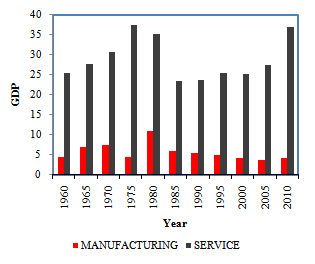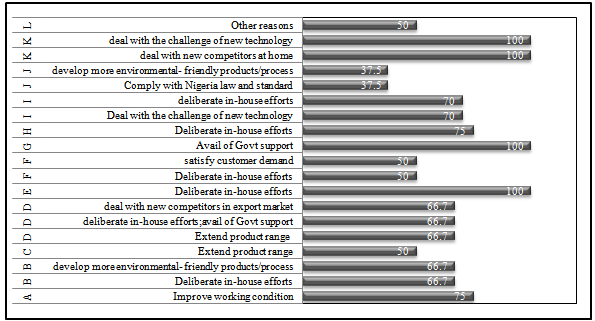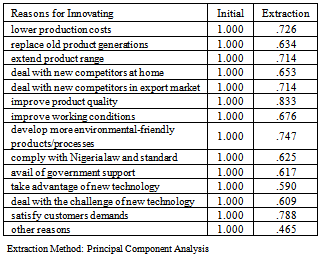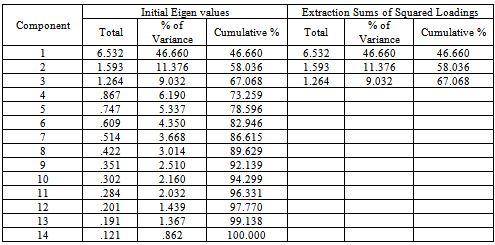-
Paper Information
- Next Paper
- Previous Paper
- Paper Submission
-
Journal Information
- About This Journal
- Editorial Board
- Current Issue
- Archive
- Author Guidelines
- Contact Us
Management
p-ISSN: 2162-9374 e-ISSN: 2162-8416
2013; 3(3): 162-168
doi:10.5923/j.mm.20130303.04
Motivation for Innovation: A Study of Nigerian Services Sector
Adewole G. O.1, Adepoju A. O.1, Adewole B. Z.2
1National Centre for Technology Management, Obafemi Awolowo University, Ile-Ife, Nigeria
2Department of Mechanical Engineering, Obafemi Awolowo University, Ile-Ife, Nigeria
Correspondence to: Adewole G. O., National Centre for Technology Management, Obafemi Awolowo University, Ile-Ife, Nigeria.
| Email: |  |
Copyright © 2012 Scientific & Academic Publishing. All Rights Reserved.
This paper examines various factors of firms’ motivation to innovate within the Nigerian services sector. This study is justified for a number of reasons. Most importantly, the sector contribution to the economy is substantial in terms of gross domestic products (GDP). But when this is compared with other developing countries apparently, it can be greatly improved. The study used a structured questionnaire of Oslo manual to obtain information from eligible respondents in various enterprises of Nigerian services sector. A total of 207 firms were investigated employing principal components method to analyze motivational factors for innovation among the enterprises. The results found three components representing very important, moderately important and least important motivating factors with an Eigen value greater than 1.0. It was revealed that satisfy customers demand, extend product range, dealing with new competitors at home, improve product quality, comply with Nigeria laws and standards and dealing with the challenges of new technology underlie very important motivating factors. The study concluded that innovation in the services sector of Nigeria economy will be more successful if the firms would extend their product range, deals with new competitors at home, comply with Nigerian laws and standards followed by the challenges of new technology as well as satisfying customers’ demand and improving product quality.
Keywords: Innovation, Motivational Factors, Services Sector, PCA, Nigeria
Cite this paper: Adewole G. O., Adepoju A. O., Adewole B. Z., Motivation for Innovation: A Study of Nigerian Services Sector, Management, Vol. 3 No. 3, 2013, pp. 162-168. doi: 10.5923/j.mm.20130303.04.
Article Outline
1. Introduction
- Innovations in the service sector constitute an important part of a national development through its contribution towards economic growth and employment generations. It accounts for a significant proportion of GDP in most countries, including low income countries, where it frequently generates over 50% of GDP[1]. The process of development usually coincides with a growing role of services in the economy with a corresponding reduced role for agriculture. Thus, services constitute an increasing percentage of GDP in nearly all developing countries. Services contributed 47% of growth in Sub-Saharan Africa over the period 2000-2005, while industry contributed 37% and agriculture only 16%[1]. Many services are key inputs to all or most other businesses e.g. infrastructure services such as energy, telecommunications and transportation; financial services which facilitate transactions and provide access to finance for investment; health and education services which contribute to a healthy, well-trained workforce; and legal and accountancy services which are part of the institutional framework required to underpin a healthy market economy. These service sectors are thus a key part of the investment climate, and can have a much wider impact on overall business performance and the level of investment, and hence growth and productivity in the economy. A well performing services sector is therefore increasingly seen as a key dimension of an effective innovation system. Based on the literature, innovation includes new products, new processes, new forms of organization, new markets and new sources of inputs to production[2]. Reference[3] define service innovation as a new or considerably changed service concept, client interaction channel, service delivery system or technological concept that individually, but most likely in combination, leads to one or more restored service functions that are new to the firm and do change the services/goods offered on the market and do require structurally-new technological, human or organizational capabilities of the service organization. In addition,[4] and[5] opine that service innovation encompass ideas, practices or objects which are new to the organisation and to the relevant environment, that is the reference groups of that innovator.The Nigerian services sector comprises of electricity; water; building and construction; road, rail, ocean, and air transport; communication; wholesale and retailing business; hotel and restaurants; financial services; real estate; housing (dwelling); private non-profit activities; as well as repairs and other services. Some of the sub-sectors are dominated by public activities especially in electricity, water, rail, ocean transport and communication services. Generally, services sector makes a significant contribution to the GDP of Nigeria than the manufacturing counterpart as evident in Figure 1. From[1], it was observed that service firms have the potential to be innovative just as the manufacturing ones.
 | Figure 1. Contribution of Services and Manufacturing Sector GDP to Nigeria Economy (Adapted from National Bureau of Statistics, NBS) |
2. Research Methodology
- The study utilized the outcomes of the 2005-2007 National Innovation Survey conducted in Nigeria. The survey collected data on all innovation activities performed by firms in the service sectors of the Nigerian economy. It covered the four types of innovation: product, process, organisational and marketing. The survey was based on the “Guidelines for Collecting and Interpreting Innovation Data (2005)” jointly developed by the Organisation for Economic Co-operation and Development (OECD), and Statistical office of the European communities (Eurostat) popularly referred to as Oslo Manual[21]. The manual proposes the standard practice for surveys on measurement of innovation. The questionnaire was also influenced partly by the Innovation questionnaire of South Africa which was based on the 3rd Community Innovation Survey. The knowledge gained from various NEPAD ASTII workshops also provided guide on the design of questionnaire and methodology use for this study as well as interpretation of key terms and concepts.
2.1. Sampling and Sampling Procedure
- Data was collected through a systematic survey of enterprises in service sectors using the multistage sampling technique. The activities were drawn from the International Standard and Industrial Classification (ISIC) revision 3.1. Firms with activities falling between divisions 50 – 99 are service. The population for the enterprises was obtained from the National Bureau of Statistics (NBS) business directory and Nigerian Stock Market trade list. The NBS Business Directory contained over 10,000 enterprises while the Stock Market trade list had about 200 enterprises actively engaged on the Capital Market. During the selection process, a census of all enterprises on the Stock Market trade list belonging to the service sectors was undertaken while a proportional probability sampling (PPS) approach with a threshold of a minimum of 10 employees was used to select firms from the NBS Business Directory.
2.2. Survey Instrument
- A structured questionnaire was used to obtain information from the eligible respondents in each enterprise between November, 2009 and July, 2010. The questionnaire requested information on the reasons for innovating among Nigeria firms.
2.3. Data Analysis
- Data Analysis was prefaced by questionnaire editing and cleaning. This was done at two levels: On-the-spot field and office editing. Data was checked manually for errors; and coding of questionnaires was done before data entry. A total of 207 administered questionnaires were returned certified and used for this study. Epidata 3.1 was used for data entry while Statistical Package for Social Sciences (SPSS version 16.0) was used to conduct statistical analysis. Descriptive statistical procedures and inferential statistic were used in analysing the data. At the univariate level, a bar chart was drawn to describe importance of various motivating factors for innovating among Nigeria firms which was rated on three point likert scale of not important, moderately important and very important. Factor analysis of the motivating factors for innovation among various firms was conducted using the Principal Components Analysis (PCA).Factor analysis refers to a variety of statistical techniques whose common objective is to represent a set of variables in terms of smaller number of hypothetical factors[22, 23]. The basic assumption of factor analysis is underlying dimensions or factors can be used to explain complex phenomena. The factor analysis of fourteen reasons for innovation by service firms were conducted using the PCA methods. The criterion for the number of factors to be extracted was that the Eigen value of each factor had to be equal to or greater than one (see reference[23] for further details). Extracted factors were then rotated by the varimax method. Each of the fourteen reasons was assign to the factor with which it had the highest correlation.
3. Results and Discussion
3.1. Descriptive Analysis
- Figure 2 described importance of various motivating factors for innovating among Nigerian firms. ‘Satisfying customer demands’ (81.6%) and ‘product quality improvement’ (73.9%) were the main motivating factors for innovation among firms in Nigeria. Taking advantages of new technology (68.6%), dealing with new competitors at home (64.7%), compliance with Nigerian laws and standard (63.1%), improving working conditions of workers (61.8%), dealing with challenges of new technologies (61.4%), developing more environmental friendly system (59.9%) and replacing the old products (52.3%) were considered moderately important motivating factors for innovating among firms in Nigeria. The least factor that motivated firms to innovate was ‘dealing with new competitors in export markets’ (38.1%). This is not surprising as majority of Nigerian firms are indigenous which produce mainly for local market.
3.2. Descriptive Statistics of the Main reasons for Innovating among different Classes of Nigeria Service Sector
- The descriptive statistics of motivating factors among different classes of Nigeria service sector were investigated and the percentage rating for each motivating factors were observed. Classifications of the main activities from the sector were obtained through ISIC 3.1 revision. The classification as shown in Figure 3 include: (A) sales maintenance and repair of motor vehicles and motorcycles; (B) wholesale trade and commission trade; (C) hotels and restaurants; (D) land transport and transport via pipelines; (E) air transport; (F) post and telecommunication; (G) financial intermediation; (H) insurance and pension funding; (I) real estate activities; (J) computer and related activities; (K) health and social work; (L) recreational, cultural and sporting activities. The percentage rating of motivating factors for innovation in different classes of Nigeria service sectors revealed that improving working conditions (75%) is the major reason for innovating in sale, maintenance and repair of motor vehicles and motorcycles subsector. Likewise, deliberate in-house effort (66.7%) and development of more environmental-friendly products or processes (66.7%) was considered as the major reason for innovating in wholesale trade and commission trade subsector of Nigeria service sector. It was also revealed that extension of product range (50%) was considered as the major reasons for innovating in hotels and restaurants while in land transports, extend product range (66.7%), deliberate in-house efforts (66.7%), dealing with new competitors in export market (66.7%) and avail of government support (66.7%) were considered as the major reasons for innovating in that subsector. Results further revealed that in air transport, the major reason for innovating is to have deliberate in house-efforts (100%) while post and telecommunication subsector of the service sector carried out innovation in order to have deliberate in house effort (50%) as well as satisfying customers’ demand (50%). Also, out of the four reasons investigated in financial intermediation subsector of service sector, avail of government support was considered as the major reason for innovating. This is not surprising as most of the financial institutions in the country are subjected to the rule and regulation of Central Bank of Nigeria and for financial relief in case of liquidating.It was also discovered from the results that in Insurance and pension funding subsector, achieving deliberate in house effort was the major reason for innovating with 75% percentage cases followed by compliance with Nigeria law and standard (66.7%). In real estate activities however, dealing with the challenge of new technology (70%) and achieving deliberate in-house efforts (70%) were the major reason for innovating. This is so as a result of complicated software and machineries required in the planning, construction and maintenance of real estates. These were followed by replacing old product generation and lower the production cost (60%). Furthermore, Computer and related activities subsector showed that replacing old products generation was the major reason for innovating with highest percentage cases of 43.8%. This is glaring as the world technology is now moving towards nanotechnology with reduced weight and higher efficiency. In fact, most of the computer devices and equipment manufactured now have replaced the old Bulky ones. Also, in health and social work subsector, dealing with new competitors at home and dealing with the challenge of new technology were the major reason for innovating with 100% cases. This is made possible due to sophisticated equipments required for the treatment of patients with cancer, heart problems etc. where in a very few hospitals are available.Finally, results for the recreational, cultural and sporting activities subsector of Nigeria service sector revealed that dealing with the challenge of new technology, deliberate in-house effort, lowering production costs and dealing with new competitors in export market were the main reasons for innovating with highest percentages of 42.9% each excluding other reasons. This is not surprising as some highly developed technological countries of the world have computerized every activity in this area.
3.3. Principal Components Analysis
- Out of the 15 reasons examined for innovating in the factor analysis (Table 1), one was associated with no factor, the ‘deliberate in-house efforts’ with communality value less than 0.5. This component is dropped from the analysis to remain 14 components. The communalities values indicate how much variance in each variable is explained by the analysis. Thus in Table 1, lowering production cost by 72.6% is explained as a reason for innovating by the extracted factors.Table 2 shows the initial Eigen value and extraction sum of square loadings of the analysis. Employing principal components analysis method of extraction, three (3) factors with Eigen value greater than 1 were extracted. The Eigen value shows a measure of how much variance in the data is explained by a single factor and they are ranked in order of how much variance each accounted for as shown in Table 2 (Total column under initial Eigen value).
 | Figure 2. Percentage Importance of motivating factors for innovating among Nigeria firms |
 | Figure 3. Percentage ratings of motivating factors for different classes of Nigeria Service Sector |
|
|
|
|
4. Conclusions
- The study concluded by resolving the motivational factors into three broad factors i.e. factors 1, 2 and 3. The components in factor 1 are regarded as the most important factors that motivate Nigerian services firms to innovate. These components includes firms’ extending their product range, dealing with new local competitors, complying with Nigerian laws and standards which is followed by the challenges of new technology as well as satisfying customers’ demand and improving product quality.
ACKNOWLEDGEMENTS
- The authors are grateful to Dr. Willie O. Siyanbola, Director-General of National Centre for Technology Management, for access to data.
 Abstract
Abstract Reference
Reference Full-Text PDF
Full-Text PDF Full-text HTML
Full-text HTML


